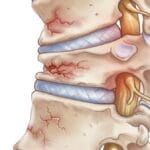Car accidents often lead to a variety of injuries, with arm pain being one of the most common, whether due to direct trauma, muscle strain, or nerve damage. Managing arm pain effectively after such an event is crucial to ensure recovery and prevent long-term complications. This article will explore the causes of arm pain after a car accident, how to treat it, and frequently asked questions about recovery and management strategies.
Causes of Arm Pain After a Car Accident
Arm pain following a car accident can result from multiple injuries:
- Whiplash: Often associated with neck injuries, whiplash can also cause pain to radiate into the arms. The sudden back-and-forth motion of the neck during a collision can impact the muscles and nerves, leading to arm pain.
- Muscle Strain and Sprain: During the impact, drivers often brace themselves against the steering wheel, which can strain muscles and ligaments in the arms and shoulders.
- Bone Fractures: Direct trauma from hitting the dashboard or other hard surfaces can cause fractures in the humerus, radius, or ulna, leading to severe arm pain.
- Nerve Damage: Injuries to the brachial plexus (a network of nerves running from the spine through the shoulder into the arm) can occur due to the trauma of a collision, leading to numbness, tingling, or shooting pain in the arms.
- Soft Tissue Damage: Muscles, tendons, and ligaments may be damaged during a collision, leading to pain, swelling, and restricted movement.
Immediate Management of Arm Pain After a Car Accident
After a car accident, it’s essential to take immediate steps to manage arm pain:
- Seek Medical Attention: Whether the pain is immediate or delayed, it’s critical to get a professional evaluation. Many injuries, such as fractures or nerve damage, may not present symptoms right away, but they can worsen over time if left untreated.
- Apply Ice: Ice therapy can help reduce inflammation and numb the area, providing temporary relief from pain. Apply ice to the injured area for 15–20 minutes at a time, several times a day.
- Rest and Immobilization: Rest the injured arm and avoid activities that could exacerbate the injury. A sling may be recommended to immobilize the arm and prevent further damage to tissues or bones.
- Pain Medications: Over-the-counter pain relievers such as ibuprofen or acetaminophen can help manage discomfort and inflammation. In severe cases, prescription pain medications may be necessary.
Long-Term Management Strategies
- Physical Therapy: Physical therapy is one of the most effective long-term strategies for managing arm pain after an accident. Therapists develop personalized rehabilitation plans to restore mobility, strengthen muscles, and improve flexibility. Regular exercises help prevent chronic pain and improve overall recovery.
- Chiropractic Care: For injuries affecting the musculoskeletal system, such as whiplash or shoulder dislocation, chiropractic care can provide pain relief and improve joint function. Chiropractic adjustments target specific areas to alleviate pressure and improve alignment.
- Massage Therapy: Massage can alleviate muscle tension, promote blood circulation, and accelerate healing. It is particularly useful for soft tissue injuries like sprains or strains that cause stiffness and soreness in the arms.
- Mind-Body Techniques: Stress and trauma from the accident can intensify the perception of pain. Techniques such as mindfulness meditation, yoga, and cognitive-behavioral therapy can help manage the psychological aspects of chronic pain, reducing stress and anxiety associated with recovery.
- Lifestyle Adjustments: Proper diet and exercise are critical to managing pain and speeding up recovery. A diet rich in anti-inflammatory foods like berries, nuts, and leafy greens can reduce inflammation, while regular low-impact exercises (once cleared by a physician) help keep muscles strong and flexible.
- Pain Management Clinics: For severe or chronic pain, visiting a specialized pain management clinic may be necessary. These clinics offer multidisciplinary approaches, including medication management, physical therapy, and interventional procedures tailored to the patient’s needs.
Frequently Asked Questions (FAQs)
What causes delayed arm pain after a car accident?
Delayed arm pain can result from whiplash, soft tissue injuries, or nerve damage. Sometimes, adrenaline or shock from the accident masks the pain initially, and symptoms don’t appear until hours or days later.
When should I seek medical attention for arm pain after a car accident?
You should seek medical attention immediately after the accident, even if the pain seems minor. Early diagnosis and treatment can prevent complications, such as chronic pain, and ensure proper recovery. Signs that warrant urgent care include intense pain, swelling, numbness, or difficulty moving the arm.
What treatments are available for nerve pain in the arm after a car accident?
Nerve pain, such as that from brachial plexus injuries, may require a combination of physical therapy, chiropractic care, and medications. In severe cases, surgical intervention may be necessary to relieve pressure on the nerves or repair damaged nerve tissue.
Can chiropractic care help with arm pain after a car accident?
Yes, chiropractic care can be very effective, particularly for musculoskeletal injuries like whiplash or dislocated joints. Chiropractors use adjustments to relieve pain, improve range of motion, and promote overall healing.
How long does it take to recover from arm pain after a car accident?
The recovery time depends on the severity of the injury. Minor strains may heal within a few weeks, while fractures or nerve injuries could take several months to fully recover. Following a structured rehabilitation plan, including physical therapy, can expedite recovery.
What can I do to prevent long-term arm pain after a car accident?
Preventing long-term arm pain involves following through with medical advice, undergoing physical therapy, and maintaining an active lifestyle. Regular check-ups and adjustments to your recovery plan ensure that any lingering issues are addressed promptly.
Conclusion
Arm pain after a car accident can stem from various causes, ranging from soft tissue damage to nerve injuries. Immediate medical attention, followed by a comprehensive pain management plan, can help alleviate symptoms and promote recovery. With the right approach—combining physical therapy, medication, chiropractic care, and lifestyle changes—you can manage pain effectively and prevent long-term complications.





